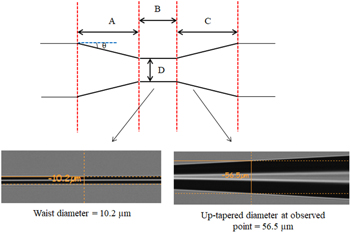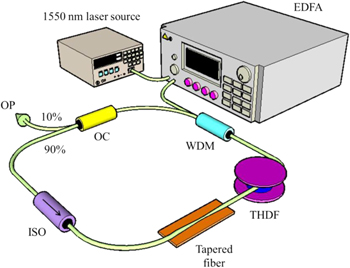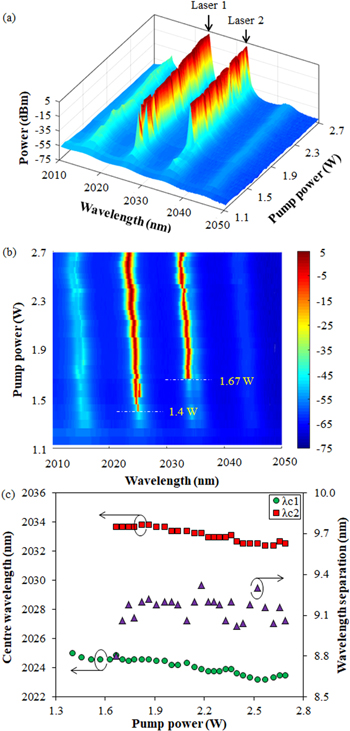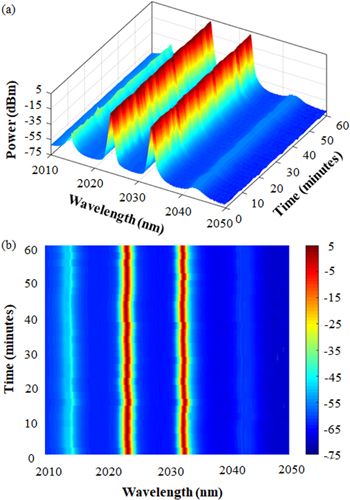Abstract
We demonstrate a dual-wavelength laser with emission in the 2 μm wavelength region using a thulium/holmium co-doped fiber and a non-adiabatic tapered fiber as a comb filter. The configuration employed a backward pumping scheme and dual-wavelength laser was generated at 2023.53 and 2032.82 nm. The side-mode suppression ratio (SMSR) is more than 44 dB with overall good stability performance. The proposed configuration presents a simple yet practical scheme of generating 2 μm dual-wavelength laser with good SMSR. This investigation may offer a more efficient yet eye safe dual-wavelength related applications for end users.
Export citation and abstract BibTeX RIS
1. Introduction
Laser applications in the 2 μm region have been widely gaining research interest, such as temperature and strain sensing [1], treatment of benign prostatic hyperplasia [2, 3], material processing, military, security and others [4]. In laser sensing and spectroscopy, 2 μm laser is suitable for eye safety application because the radiation is absorbed in the vitreous body of the human retina [4]. In medicine, the high absorption in water and minimal penetration depth into human tissue of 2 μm continuous wave (CW) laser are suitable for surgeries involving nervous, respiratory, and urinary systems [4]. Holmium and thulium are rare-earth elements that are utilized to generate 2 μm lasers. Thulium-based laser has an advantage over holmium-based laser due to smaller penetration depth into human tissue, improved spatial beam quality, and higher resolution of tissue incision [3, 4].
Emission in the 2 μm can be achieved through the pumping of either thulium-doped fiber or holmium-doped fiber. Utilizing one or both of these doped fibers, numerous types of laser configurations have been investigated such as mode-locking [5], Q-switching [6], and multi-wavelength lasers [7]. However, investigations on dual-wavelength lasers in the 2 μm wavelength fall short. As of yet, only holmium-doped fiber has been utilized to generate simultaneous dual-wavelength laser emission at 2075 and 2083 nm [8], 2067.0 to 2073.5 nm [9], 1950 and 2100 nm [10], as well as 2049 and 2153 nm [11]. For thulium-based fiber lasers, dual-wavelength generation has only been achieved at wavelengths shorter than 2 μm [12–14] while dual laser generation longer than 2 μm is rather difficult with thulium-doped fiber due to the inherent decreased gain per unit wavelength. This contrasts to holmium ion with absorption from 5I8 to 5I7 energy state with emission ranging from 2.0 to 2.1 μm [8], making it the easier option.
Dual-wavelength lasers stand on their own merits as an application. For instance, temperature and strain sensing can be probed by analyzing the wavelength shift between the dual lasers [1]. A widely tunable dual-wavelength was proposed to tune the CW terahertz radiation [15]. Other dual-wavelength laser applications include step-height measurement using self-mixing interferometry [16], transverse load sensing [17], and medical treatment [18]. One of the possible methods to generate dual-wavelength laser is through the integration of a comb filter which generates wavelength-dependent fringes. Comb filters can be realized using spatial mode-beating from phase-mismatch at splicing points [12], high birefringence fiber loop [9], tapered fiber [19], and Mach–Zehnder interference filter [20]. To extract channels from the multi-wavelength generation, additional wavelength selective elements such as fiber Bragg grating (FBG), arrayed waveguide grating and tunable bandpass filter are usually used to filter the background noise. Numerous techniques were demonstrated and investigated in the recent works on 2 μm dual-wavelength thulium-doped fiber laser (TDFL). For instance, FBGs and highly birefringent (Hi-Bi) fiber optic loop mirror (FOLM) was integrated to independently tune laser lines and cavity loss, respectively to achieve stable dual-wavelength operation [21]. In addition, Hi-Bi FOLM was also utilized to produce tunable narrow linewidth TDFL [22]. On the other hand, the temperature variation of Hi-Bi FOLM was proposed to allow dual-wavelength generation [23]. The use of multimode interference filters in the Mach–Zehnder interferometer was also demonstrated for the generation of dual-wavelength laser lines [24]. Various techniques of tuning mechanism in dual-wavelength laser systems were achieved by applying strain on FBG [25] and tapered fiber [26].
In this work, we experimentally demonstrate a simple yet practical 2 μm dual-wavelength laser configuration. The dual-wavelength laser emits at 2023.53 and 2032.82 nm, corresponding to 9.32 nm in wavelength separation and side-mode suppression ratio (SMSR) of more than 44 dB. The proposed configuration achieves dual lasing via a thulium–holmium co-doped fiber (THDF) with non-adiabatic tapered fiber integrated as the comb filter. The performance of the proposed setup highlights major improvement in SMSR and emission at longer wavelengths in comparison to previous research works.
2. Optical characterization of non-adiabatic tapered fiber
Figure 1 depicts the setting of a single-mode tapered fiber parameter. The tapering process is conducted using Vytran GPX-3400 automated glass processor. Lengthwise, the tapered fiber can be divided into several regions; up-tapered, waist, and down-tapered denoted as regions A–C, respectively, in figure 1. The waist diameter of the tapered region is denoted as region D. A symmetrical non-adiabatic tapered fiber is designed with 5 mm length for up-tapered and down-tapered regions, 10 mm for waist length (B), and 10 μm for waist diameter (D). The designed tapered fiber falls under the category of non-adiabatic tapered fiber parameter based on the taper angle (θ) of more than 2 mrad [27]. The non-adiabatic mechanism of the tapered fiber is crucial in producing optical fringes as the comb filter.
Figure 1. Parameter setting of non-adiabatic single-mode tapered fiber.
Download figure:
Standard image High-resolution imageThe transmission characteristic of this tapered fiber is performed beforehand to gauge its behaviour in the 2 μm region. In order to perform this experiment, a 2 μm amplified spontaneous emission (ASE) source is first constructed by pumping 10 m long thulium-doped fiber with an amplified 1550 nm laser source. The transmission characteristic of the tapered fiber is recorded by comparing the ASE spectrum between the reference (without tapered fiber) and with tapered fiber. These spectra are measured using a Yokogawa AQ6375B Optical Spectrum Analyzer with 0.05 nm resolution. The wavelength of interest is investigated from 1985 to 2055 nm as illustrated in figure 2. The central wavelength of comb filter 1 (CF-1) and comb filter 2 (CF-2) are 2025.54 and 2035.28 nm with free spectral range (FSR) of 9.34 nm. The 3 dB bandwidth of CF-1 is 5.34 nm from 2022.92 to 2028.26 nm. On the other hand, the 3 dB bandwidth of CF-2 is 5.36 nm from 2032.56 to 2037.92 nm. These two filters are selected as the point of interest owing to lasing behaviour of the proposed laser setup that will be discussed in the following section.
Figure 2. Transmission of non-adiabatic tapered fiber as comb filter at 2 μm region.
Download figure:
Standard image High-resolution image3. Experimental setup of 2 μm dual-wavelength laser
The experimental setup of 2 μm laser cavity is portrayed in figure 3. A 1550 nm laser source amplified with erbium-doped fiber amplifier is employed to pump a section of 15 m THDF (model: TH512 by Coractive) via a 1550/2000 wavelength division multiplexer. The THDF has absorption of approximately 17 dB m−1 at 1550 nm, meanwhile the LP11 cut-off wavelength is 1686 nm. Then, the non-adiabatic tapered fiber operating as the comb filter is spliced after the THDF. A polarization independent isolator (ISO) is inserted in counter-clockwise regime to ensure unidirectional signal propagation and backward pumping scheme of the proposed laser setup. An optical coupler is used to divert 10% of the signal out from the laser cavity for output measurement, whereas the remaining 90% laser signal reverts into the input port of ISO and completes the laser cavity.
Figure 3. Experimental setup of 2 μm laser cavity.
Download figure:
Standard image High-resolution image4. Fiber laser performance
Figure 4 shows the laser emission at 2.69 W pump power without implementing the tapered fiber. The laser emission in free-running laser regime is observed with emission from 2018 to 2024 nm. This wavelength range is in between the typical emission wavelength range for thulium and holmium ions of 1.88 μm to 1.98 μm [28] and 2.08 μm [8], respectively.
Figure 4. 2 μm free-running laser at 2.69 W pump power without the non-adiabatic tapered fiber.
Download figure:
Standard image High-resolution imageFigures 5(a) and (b) show the perspective and top view of optical spectrum for 2 μm laser with tapered fiber inserted into the laser cavity. Based on figure 5(a), two laser lines are observed which are denoted as Laser 1 (short wavelength) and Laser 2 (long wavelength). From the proposed laser setup, Laser 1 is observed to be more dominant than Laser 2. Based on figure 5(b), Laser 1 is generated at pump power of 1.40 W whereas Laser 2 is initiated at 1.67 W pump power. The discrepancies in central wavelength and wavelength separation between both laser lines are depicted in figure 5(c).
Figure 5. (a) Perspective view, (b) top view of optical spectrum and (c) central wavelength and wavelength separation between two laser lines
Download figure:
Standard image High-resolution imageBased on the experimental findings, the central wavelength of Laser 1 (λc1) and Laser 2 (λc2) are generally blue-shifted as the pump power is increased. Higher laser pump power corresponds to the increase in temperature [29]. Li et al [30] investigated the relationship between the change in temperature, ΔT and the wavelength shift, Δλ, which is expressed as:

where α is the thermal expansion coefficient. According to [31], the peak position of the spectrum is blue-shifted at higher temperature due to negative thermo-optic coefficient of the silica glass. Based on the experimental findings, the discrepancies of λc1 from 1.40 to 2.69 W pump power and λc2 from 1.67 to 2.69 W pump powers are 1.78 nm (2023.22–2025.00 nm) and 1.44 nm (2032.38–2033.82 nm), respectively. These wavelength regions falls within the 3 dB bandwidth of the comb filters (see figure 2). Next, the wavelength separation between λc1 and λc2 are within the range of 8.80–9.32 nm. The minor deviation of the wavelength separation between λc1 and λc2 to the FSR of the comb filter in figure 2 could be due to the mode-competition that exists within the filtered bandwidth.
Figure 6 exhibits the optical spectrum of the 2 μm dual-wavelength laser performance at 2.69 W maximum pump power. The separation between the two laser lines is 9.06 nm, which is close to the FSR imposed by the comb filter observed in figure 2. The SMSR is recorded as 45.3 dB and 44.1 dB for Laser 1 and Laser 2, respectively. In comparison to other 2 μm dual lasers with the SMSR measurement of 21 and 30 dB [12], as well as 17 dB [8], 34 dB [32], and not more than 43 dB [13] for both laser lines, it can be concluded that the proposed setup generated a 2 μm dual-wavelength laser with higher SMSR than previous works. This is attributed to the extinction ratio of our proposed tapered fiber which is ∼7.8 dB (see figure 2). The SMSR is obtained as more than 44 dB for both laser lines with the spontaneous emission power level of −42.6 dBm. High extinction ratio of the tapered fiber efficiently suppresses the spontaneous emission power level. From [12], the extinction ratios for the filters were recorded around 2 dB, with spontaneous emission power level of approximately −35 dBm. This resulted in a lower SMSR measurement. Nevertheless, a lower spontaneous emission power level of −52 dBm with approximate filter extinction ratio to [12] was reported in [13]. In comparison to this work, the higher value of filter extinction ratio produces a better quality of laser lines in terms of SMSR. As depicted in figure 6, by removing the lower peak around 2014.4 nm, the SMSR can be further enhanced to 66 dB.
Figure 6. Optical spectrum of 2 μm dual-wavelength lasers measured at 2.69 W pump power with resolution bandwidth 0.05 nm.
Download figure:
Standard image High-resolution imageFigure 7(a) shows the average output power development against pump power measured using an optical power meter. From the graph, the laser threshold takes place at 1.40 W pump power. Beyond the laser pump power threshold, the average output power increases linearly with slope efficiency of 0.93%. In order to determine the exact power of the laser lines individually, the optical spectrum is numerically integrated from 2018.90 to 2028.10 nm for Laser 1 and from 2028.10 to 2037.30 nm for Laser 2. The output power of the individual lasers as a function of pump power is depicted in figure 7(b). Region X denotes the spontaneous emission while region Y shows a stable growth of output power for both lasers. In region Y, the power threshold for Laser 1 is 1.40 W and for Laser 2 is slightly higher at 1.67 W, matching the observation in figure 5(b). In region Z, the scattering of the data points that breaks off from the linear trend is predicted with several possibilities, the inhomogeneous surface of the tapered fiber and the generation of self-phase modulation (SPM) due to the nonlinear effect of the tapered fiber. In high power operation, the inhomogeneous surface of the tapered fiber may induce some 'hot spots'. These hot spots on the tapered fiber increase the temperature of the peripheral air. Successively, the phase of the propagating light through the hot spot may be affected due to the thermo-optic effect [33]. Eventually, this leads to the unstable lasing oscillation due to the phase fluctuation of the oscillating light in the laser cavity. In addition, high intensities of light may induce SPM, which causes spectral broadening. As a result, more frequency components are beating in each wavelength, which causes lasing fluctuation.
Figure 7. (a) Power development curve for 2 μm laser and (b) for individual laser lines.
Download figure:
Standard image High-resolution imageThe stability performance of the 2 μm dual-wavelength laser is examined within an observation period of 60 min at 2.69 W pump power. The perspective and top views of the stability measurement is depicted in figures 8(a) and (b). Based on the experimental observation, minor deviations in central wavelength and peak power are observed for the dual-wavelength lasers throughout the experiment.
Figure 8. (a) Perspective view and (b) top view of stability test for 2 μm dual-wavelength lasers over 60 min.
Download figure:
Standard image High-resolution imageSubsequently, the stability performance measurements of both laser lines are analyzed in terms of central wavelength, spectral bandwidth, peak power and SMSR. The measurements for these four parameters are tabulated in table 1. According to the parameter sequence aforementioned, Laser 1 obtains mean values of 2023.56 nm, 0.2474 nm, 2.033 22 mW and 45.68 dB; and standard deviation values of 0.089 03 nm, 0.025 82 nm, 0.1353 mW and 0.2931 dB. On the other hand, Laser 2 records mean values of 2032.73 nm, 0.2174 nm, 1.4551 mW, and 44.14 dB; while standard deviation values attained are 0.1153 nm, 0.017 88 nm, 0.0910 mW and 0.3390 dB. The rather small deviation of the central wavelength and spectral width presents an overall stable dual-wavelength laser generation with high SMSR in the 2 μm region. In addition, the standard deviation in wavelength separation between both laser lines over 60 min are calculated at 0.0756 nm, which defines the suitability of the proposed work for sensing based on wavelength modulation.
Table 1. Sample mean and standard deviation in central wavelength, spectral bandwidth, peak power, SMSR and wavelength separation for Lasers 1 and 2 over 60 min observation time.
| Sample mean | Sample standard deviation | |||
|---|---|---|---|---|
| Laser 1 | Laser 2 | Laser 1 | Laser 2 | |
| Central wavelength (nm) | 2023.56 | 2032.73 | 0.089 03 | 0.1153 |
| Spectral bandwidth (nm) | 0.2474 | 0.2174 | 0.025 82 | 0.017 88 |
| Peak power (mW) | 2.033 22 | 1.4551 | 0.1353 | 0.0910 |
| SMSR (dB) | 45.68 | 44.14 | 0.2931 | 0.3390 |
| Wavelength separation (nm) | 9.1752 | 0.0756 | ||
5. Conclusion
We have successfully demonstrated a viable dual-wavelength laser at 2023.53 and 2032.82 nm with high SMSR of more than 44 dB. This is accomplished by pumping a section of THDF with 1550 nm pump wavelength and a non-adiabatic tapered fiber as the comb filter. The laser line at shorter wavelength (Laser 1) is initiated at 1.40 W whereas the longer laser line (Laser 2) is generated starting from 1.67 W. In terms of stability, Laser 1 and Laser 2 both possess low standard deviations of 0.089 03 nm and 0.1153 nm in central wavelength, 0.025 82 nm and 0.017 88 nm in spectral bandwidth, 0.1353 mW and 0.0910 mW in peak power, and 0.2931 dB and 0.3390 dB in SMSR. The proposed stable configuration with high SMSR is sufficiently practical for typical dual-wavelength applications while offering a safer environment to users. Standard deviation for wavelength separation between both laser lines is 0.0756 nm, which defines its suitability for sensing based on wavelength modulation. On top of that, the operation of the proposed dual laser in the 2 μm region, could potentially grant more effective and open up new possibilities for dual-wavelength applications.
Acknowledgments
The authors extend their appreciation to the International Scientific Partnership Program ISPP at King Saud University for funding this research work through ISPP#0106.









